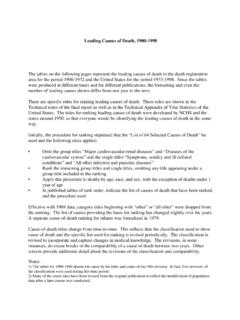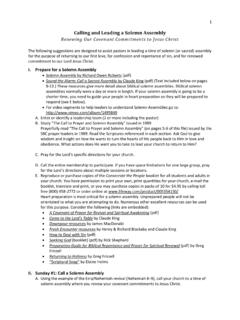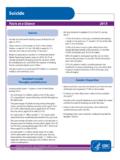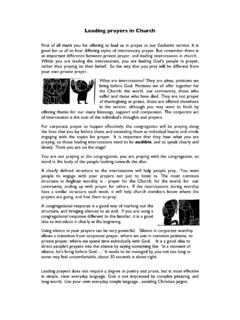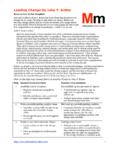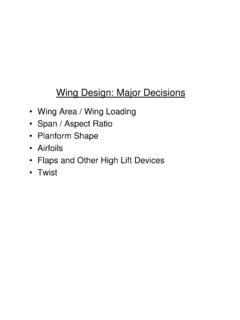Transcription of thought leadership - Leading Thoughts | Research, advice ...
1 Mignon van HalderenKym Kettler-PaddockCraig Badingsthought leadership How to differentiate your company and stand out from the crowd: thought leadershipThis is a manuscript in progress and currently shared for the purpose of exchanging knowledge and ideas with peers and other parties interested in thought leadership . If you are going to quote from the manuscript you need to give full attribution to the authors. A final booklet is published in June 2013 by the Adformatie Groep in IntroductionIncreasingly, B2B and B2C businesses are using thought leadership to build their brand, develop brand awareness, create an unique platform for competitive differentiation, build deeper relationships with customers, be heard above all the noise in the marketplace and engage important stakeholders on board with a company s strategic plans. 1 Businesses are using an array of delivery mechanisms such as white pa-pers, events, webinars and the like, but what constitutes effective thought leadership is either vague or misunderstood.
2 Some companies confuse their use of new delivery mechanisms with having a thought leadership strategy ( we have white papers therefore we are a thought leader ). Furthermore, the thought leadership mechanisms that lead to positive outcomes are either not known or have not been properly studied and articulated. To create a better insight into what thought leadership means, its busi-ness value and how organizations pursue it, we conducted case studies of six corporate thought leaders. The results underpin our definition of thought leadership one that is based on the two key pillars of trust and novelty. They also help in identifying a framework for creating corporate thought leadership . 4In this e-book, we explain our definition of thought leadership and review our four-step thought leadership Framework TM. We explain each of the four steps, relate each step to actual case studies and use theory to explain why these steps generate the results that they do.
3 In doing so, we hope that this book will support managers in successfully pursuing their thought leadership , Kym & Craig5 Why thought leadership ? In an era in which stakeholders are keen to hear refreshing viewpoints that overturn status-quo thinking and trigger change, thought leadership provides companies with a means to substantially raise their profiles among customers and other stakeholders ( , employees, business part-ners, the government or non-government organisations). Customers (and other stakeholders) are constantly seeking novel per-spectives and new insights into issues that matter to them. This happens in the business-to-business and the business-to-consumer market. For instance, city architects around the world are searching for novel ideas on how to keep cities livable in the future in the face of soaring populations. Two companies on which we focus, IBM and Philips meet these needs by providing convention-challenging solutions drawn from their corporate expertise on complex issues surrounding these are attracted to brands that challenge the status quo of the-mes that touch their daily lives ( beauty, health, lifestyle, connectivity, etc).
4 For example, Dove (a personal-care brand owned by Unilever) has tapped into women s concerns about society s unrealistic standards of beauty by seeking to widen the definition of beauty to include all leadership gives companies with novel perspectives and soluti-ons the opportunity to substantially raise their profiles and remain on the cutting edge of developments in their markets and societies. Customers are drawn to thought leaders because of their refreshing viewpoints on wider issues and challenges that matter to them and as a result, come to regard the firm as their trusted advisor in the market. 7 What is thought leadership ? Definition of thought leadershipBusiness literature suggests a number of definitions: Crainer and Dear-love wrote that thought leadership is a strategy that positions the brand as intellectually superior to the competition while Celi and Miller called thought leadership an intellectual engagement.
5 2 Vanden Heuvel and Badings defined thought leadership as the successful promotion of a company s unique point of view, insight, or solution which leads to significant customer engagement. Manasco asserted that thought leadership is the presentation of insightful, provocative and compelling perspectives that frame the way people think about key issues and even guide them to smarter decisions. 3We define thought leadership as The action of promoting thought -provoking viewpoints that reframe the way customers think about their key issues, helping them toward new insights and solutions. 8 Figure 1: Definition of thought leadership There are several important components within our definition of thought leadership . First, our definition focuses on customers but thought leadership can be directed at any key stakeholder. thought lea-dership is not a broad based or mass appeal activity, rather it is targeted to specific members of stakeholder groups depending on the corpora-tion s desired outcome and the needs of those stakeholders (customers, business decision makers, employees, policy makers, the media, local governments, business partners, NGO s etc.)
6 For the purpose of practi-cality in explaining our concepts, the majority of this e book focuses on customers or prospects. We do highlight examples where other stakehol- The action of promoting thought -provoking viewpoints that reframe the way customers think about their key issues, helping them toward new insights and are targeted to give a fuller picture of how thought leadership can work across multiple audiences. Second, thought leaders seek to change how customers think with the in-troduction of a Novel Point of View. Companies already have an arsenal of tools with which they attempt to persuade customers: advertisements, product features and benefits, logic, etc. But thought leaders are not just clever advertisers, although advertisements may play a role in a thought leadership strategy. Rather, thought Leading companies are at the fore-front of their industries not necessarily in terms of sales value, but in terms of ideas.
7 In a crowded marketplace, the natural human tendency to seek out novelty means that customers will notice novel ideas and spend time considering them. Novelty helps the thought leader stand out from the pack. Of course the products, solutions or services have to work, but their novelty is what attracts customers and makes them consider the possibilities offered by the thought leader. Lastly, thought leadership is about converting interest in a new idea into acting on that idea to the mutual benefit of the thought leader, the customer or other stakeholders. In its purest theoretical form, thought leadership is about changing how customers think about a given issue. However, corporations do not pursue thought leadership for theoretical reasons: they need to attract customers, address their needs and deliver 10a return. thought leadership should aim for an improved situation for the customer ( decreased cost, improved performance, better policy, increased profit, a better way of doing something) and in some cases society at large.
8 thought leadership is not just innovation or having a strong visionTo get a better handle on the term thought leadership , we need to make a distinction between two related concepts: innovation and vision. Innovation is the process that translates an idea or invention into a product or service for which customers are prepared to pay. Innovation disrupts the status quo in product and service use ( , a new flavour of toothpaste or replacing horse-drawn carriages with automobiles), but does not necessarily entail novel thinking that goes beyond the product or service. thought leadership implies having a strong thought -provoking viewpoint on an area of interest that goes beyond the product or service. In an era in which society is facing truly daunting societal, economic and environmental issues, innovative products by themselves are no longer enough. Customers are on the lookout for refreshing viewpoints that break from old thinking.
9 IBM, for instance, didn t come up with a good idea on how to use their innovative analytical system to reduce energy consumption in homes and offices: they developed a novel and thought -11provoking perspective on the entire spectrum of energy. thought leadership needs innovation in order to thrive: innovation delivers the new products and services that thought leaders provide to meet their cus-tomers needs. However, new products (no matter how great or revoluti-onary) do not make companies into thought leaders. They are a necessary component, but not the whole. thought leadership is a differentiated competitive position that leverages the power of insight and innovation and applies it to customers biggest needs, issues and challenges. A company s vision is what it aspires to be in the medium to long term future. Companies visions can be inspiring and ambitious, but not all visions challenge the status quo.
10 thought leadership implies having a strong thought -provoking viewpoint on an area of interest to its custo-mers which may overlap with the corporate vision in some way. Regar-dless, thought leaders generate a point of view or perspective that flies in the face of conventional wisdom and stimulates new thinking. They see the world differently and are willing to share their unique insights first and foremost and only then see how their products and services can help solve their customers two pillars of thought leadership : novelty and trust thought leadership is based on two important pillars: novelty and trust 12(see figure 2). First, thought Leading corporations have a novel point of view (NPOV) which they promote to their stakeholders as an idea, insight or solution for a market or societal issue. The novelty of the viewpoint attracts the attention of the customer and incentivizes them to spend time considering it.
